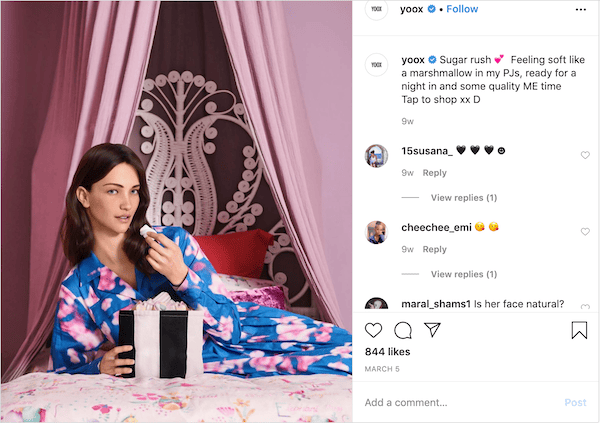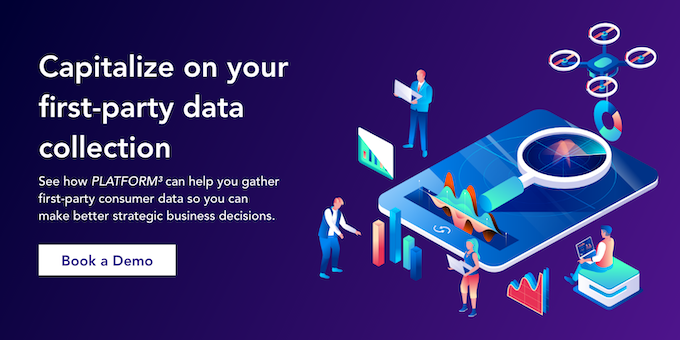Guide to Metaverse Marketing (Examples Included)
In today’s personalization-driven world, people are looking for unique, immersive experiences that lead to stronger connections and deeper relationships, both with other consumers and with their favorite brands. However, Americans see anywhere from 4,000 to 10,000 ads per day, making it increasingly difficult for companies to stand out from the crowd. To fulfill consumers’ evolving expectations, marketers are turning to virtual and augmented reality, expanding their omnichannel strategies and boosting user engagement at the same time. Some brands even create their own virtual worlds in the metaverse, the next stage of experiential technology. What is the metaverse, and how does it work?
What is the metaverse?
The metaverse is a universe within a universe. From a technological perspective, metaverses are virtual worlds where people create avatars, seek experiences, interact with other users, and purchase digital products like clothing and artwork. Metaverses are often closely associated with Web3, a new iteration of the World Wide Web focused on blockchain technologies like cryptocurrency and non-fungible tokens (NFTs). Some of the most well-known metaverses include Meta’s Horizon Worlds, Sandbox, Decetraland, Epic Games’s Fortnite, and Roblox.
While the metaverse became a hot topic in recent years across many different industries, the concept has actually been around for decades. In 1956, American filmmaker Morton Heilig created the first VR machine, the Sensorama, to simulate the feeling of riding a motorcycle. NASA developed VR technology for astronaut training sessions in the 1980s, while video game companies like Sega started creating VR arcade machines in the 1990s. The term “metaverse” first appeared in Neal Stephenson’s 1992 sci-fi novel, Snow Crash; the concept was also seen in Ernest Cline's Ready Player One and William Gibson's Neuromancer. Finally, in 2011, Palmer Luckey developed the prototype for the Oculus Rift headset, which became available for purchase in 2016. This led to the invention of Google Glass, Microsoft’s HoloLens, Sony’s Playstation VR, and many others, paving the way for the metaverse.
Virtual reality vs. augmented reality
Some companies join or even develop their own virtual worlds, while others create smaller-scale brand experiences with augmented reality. In virtual reality, users view three-dimensional images using specialized hardware. In augmented reality, users view the real world with additional visual, haptic (touch), or olfactory (smell) elements. Brands use these technologies to either demonstrate their products and services or let consumers test them for themselves, increasing the chances of sales and conversions.
For example, Lowe’s Holoroom teaches consumers how to use their products using HTC Vive headsets and controllers. The virtual reality experience provides tutorials for home improvement projects like installing bathroom tile or using a hedge trimmer. Lowe’s also uses their Holoroom technology to provide employee training for in-store equipment. Both applications help instill trust and confidence in its users, resulting in better employees and well-informed consumers who are more likely to make a purchase.
Augmented reality, on the other hand, is especially popular with brands in the decor, apparel, and beauty industries, allowing consumers to test and buy products from the comfort of their own homes. For example, Sephora’s Virtual Artist app lets users try makeup products like eyeshadow and lipstick from various brands. It also provides tutorials where users can learn different makeup techniques on their own faces. Like with virtual reality, augmented reality also increases the chances of consumers making a purchase, as they have a better understanding of whether a product is right for them.
Benefits and challenges of the metaverse
Benefits of the metaverse
The main advantage of the metaverse is its endless potential for new brand opportunities, giving companies more ways to interact and connect with consumers. For example, they can purchase virtual real estate to build storefronts and brand installations. They can create unique games and immersive experiences to encourage engagement and conversions. Lastly, they can participate in or host virtual events like conferences and meetups. For example, to promote the release of their upcoming movie, In The Heights, Warner Bros. Pictures hosted a virtual event in Roblox’s metaverse. Fans explored the film’s Washington Heights location, joined a cast Q&A and dance party, and purchased virtual merchandise.
Brands can also use the metaverse to partner with other brands and build relationships with customers and virtual influencers, expanding their reach and increasing their credibility. For example, they can advertise or sponsor metaverse content in other brands’ spaces using virtual billboards, QR codes, and so on. They can create avatars to provide one-to-one customer service, rather than connecting solely through phone or email. Lastly, they can ask influencers to talk about their brand, showcase their products, and participate in their virtual events. Some companies even create their own influencers to represent their brand’s personality. For example, YOOX, a luxury e-commerce company, created “Daisy”, a virtual model who’s been featured in promotional campaigns for Calvin Klein, Tommy Hilfiger, and Ralph Lauren.
Lastly, the metaverse helps brands capture zero-party and first-party data about their consumers. This strengthens their ability to segment their audiences and create personalized marketing campaigns, such as product recommendations and targeted messages. With user data, companies can better understand and serve their consumers’ needs, turning potential customers into eventual brand advocates for increased customer lifetime value and ROI. The metaverse allows brands to track user journeys and gain deeper insights into consumer behavior, such as the steps taken when they purchase a virtual product or attend a virtual event.
Challenges of the metaverse
The main disadvantage of the metaverse is its complexity, both from a technical perspective and a marketing perspective. Developing and maintaining quality virtual experiences requires a lot of time, knowledge, and resources that brands may not necessarily have. Marketers might also not fully understand the implications and applications of the metaverse or how to seamlessly integrate it with their existing campaigns, leading to poor virtual experiences that reflect negatively on their brand. To avoid these missteps, brands should consider starting with smaller-scale VR and AR experiences to learn how to utilize the technology. For example, they can add an augmented try-on feature to their website or create a virtual experience for customers in physical stores. From there, they can determine whether joining the metaverse is the best course of action for their company and their consumers.
Brands also need to be cautious about intellectual property management, user safety, and data privacy, as consumers are becoming increasingly concerned about the ownership and use of their personal information. While the metaverse makes it easier than ever to capture first-party data, brands should prioritize best practices for securing user information and consent to gain their trust. They need to set guidelines for how to responsibly collect and share data, understand how to safely move data between different platforms, and develop efficiencies for how to analyze data and turn it into actionable insights.
Perspectives on the metaverse
Consumer perspectives
According to a study conducted by Wunderman Thompson Intelligence, around 74% of consumers know of the metaverse, but only 15% felt confident that they could explain it. Some consumers correctly describe it as a virtual world, while others believe the metaverse is a new social media platform or an emerging tech company. Another survey by market research firm Ipsos found that consumer familiarity depended on the respondent’s age and the presence of children in their household. However, according to a survey by McKinsey & Company, awareness and usage will soon increase exponentially, with younger generations like millennials and Gen Zers predicted to spend five hours per day in virtual worlds within the next five years.
Brands often assume that the only consumers who are either interested in or are already exploring the metaverse are people who regularly play video games. However, McKinsey & Company found that consumers are looking for a breadth and depth of different virtual experiences in addition to social gaming, including shopping, appointments and events, learning and development, and connecting with colleagues, family, and friends.
Lastly, as mentioned previously, one of the biggest consumer hurdles of the metaverse is privacy. In addition to general concerns about data collection and ownership, such as whether personal information will be bought and sold, parents are worried about their children’s safety, especially regarding cyberbullying, age-appropriate content, and anonymity. Many consumers are hesitant to engage with the metaverse or VR/AR technology in general because the ethical and legal framework is still evolving.
Brand perspectives
A survey conducted by social analytics company ListenFirst found that only 18% of marketing executives understand how the metaverse will impact their brand, while nearly half of respondents were only “somewhat sure” of what it means. On the other hand, household names like Disney, Nike, and Coca-Cola are already investing significant amounts of capital into the metaverse. It’s expected to be worth around $800 billion by 2024, up from $47 billion in 2020, and may potentially create jobs for millions of people.
Not all brands need or want to invest in the metaverse, as many are still balancing the risks and rewards. Some marketers even dismiss the metaverse as a passing fad. However, as consumer perspectives continue to shift, more companies should consider whether it could have a positive impact on their brand. If their target audience or their competitors already have a significant presence in the metaverse, they may want to look for virtual opportunities to avoid being left behind.
Like consumers, brands are also cautious about how to responsibly collect and leverage user data, as the metaverse’s privacy laws are still in development. It’s expected that these laws will vary by country or even by state or city, similar to the EU’s General Data Protection Regulation (GDPR) and independent state statutes like the California Consumer Privacy Act (CCPA) and the New York SHIELD Act. Brands with widespread operations may find it difficult to keep up with these regulations and their effects on their company-consumer relationships.
Government perspectives
Many governments around the world are considering both how to regulate the metaverse and how to use it to their advantage. To start, some are debating whether the metaverse should be a centralized or decentralized model. Policymakers are also determining how to govern the metaverse’s economy, including virtual transactions and taxation, as well as the previously mentioned topics of data ownership, cybersecurity, and user privacy. Lastly, governments need to develop laws to ensure that the metaverse is accessible, inclusive, and equitable for as many people as possible.
Government agencies are already leveraging virtual and augmented reality, especially as of recently due to COVID-19. For example, some use the technology to recruit and train employees, while others use VR/AR for city and community planning. Some local governments use it to conduct town hall meetings. Lastly, some use it to create virtual tours and enhanced navigation apps to share their culture and boost tourism.
Currently, most governments are still hesitant to fully embrace the metaverse because of the limited knowledge on its return on investment and user demand. However, a number of American universities are developing metaverses of school campuses to improve remote learning. Countries like South Korea are working towards a “full-service virtual world” where residents can visit cultural sites, reserve city-run facilities, and more. While governments may be slower to adopt the technology when compared to brands, some are cautiously interested in investing in the metaverse for the future.
Create data-driven brand experiences to boost consumer engagement
With today’s consumers seeking out immersive and innovative brand experiences, many companies are creating their metaverse footprint by offering virtual products, events, and more. However, there are also a number of companies and consumers who are hesitant to adopt new technology because of data privacy and safety concerns. Brands who responsibly collect and leverage their users’ first-party data are more likely to earn their trust than those who don’t, whether inside or outside a virtual world.
With 3 tier logic’s PLATFORM³, brands can develop personalized marketing campaigns like loyalty programs, contests and giveaways, and gift with purchase promotions to drive sales and capture first-party data for actionable insights. Modules like Dynamic Messaging, Points & Gamification, and Data Capture & Analytics provide marketers with the tools and information they need to successfully engage with their customers. To learn more, chat with an expert today.







